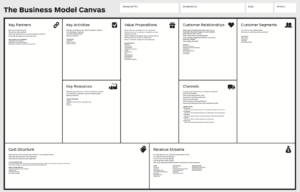What is it?
The Business Model Canvas is a strategic management tool used to develop and document business models. It provides a visual framework for analyzing and describing how a company creates, delivers, and captures value. The canvas is divided into nine key building blocks:
- Customer Segments: Identifies the target customer groups.
- Value Proposition: Describes the unique value a company offers to its customers.
- Channels: Outlines how products/services are delivered to customers.
- Customer Relationships: Defines the types of interactions a company has with its customers.
- Revenue Streams: Lists the sources of revenue for the business.
- Key Resources: Identifies the critical assets and resources required for the business.
- Key Activities: Describes the key actions the company must take to deliver value.
- Key Partnerships: Lists external entities that the business collaborates with.
- Cost Structure: Details the costs associated with operating the business.
How do we use it?
The Business Model Canvas was developed by Alexander Osterwalder and Yves Pigneur and is widely used in both the startup and corporate world for various purposes:
- Startup Planning: Entrepreneurs use the canvas to brainstorm and refine their business ideas. It helps them identify potential gaps in their business models and make necessary adjustments to increase their chances of success.
- Strategic Management: Established companies use the canvas to assess and adapt their existing business models. This tool is especially valuable when exploring new markets, launching new products, or undergoing significant strategic shifts.
- Communication Tool: The canvas simplifies complex business concepts, making it an effective communication tool. It helps teams and stakeholders understand and align on the key components of a business model.
- Innovation: The canvas encourages innovation by prompting organizations to question existing assumptions and explore new opportunities. It fosters a culture of continuous improvement.
- Investor Pitch: Startups often use the Business Model Canvas as a visual aid during investor pitches. It provides a concise overview of the business and its potential for investors.
To create a Business Model Canvas, you typically start by brainstorming and filling in each of the nine building blocks with relevant information. Teams may iterate on the canvas as they gather more insights and feedback from customers and stakeholders. It’s a dynamic tool that evolves with the business.

Example
Let’s use a chocolate shop as an example to explain the Business Model Canvas. In this scenario, we’ll break down the key components of the canvas for a chocolate shop business:
- Customer Segments:
- Families
- Office workers
- Students
- Chocolate enthusiasts
- Value Proposition:
- Delicious, high-quality chocolate
- Fast and reliable delivery service
- Variety of chocolate toppings and styles
- Cozy dine-in experience
- Channels:
- Dine-in shop
- Online ordering website and app
- Phone-in orders
- Food delivery apps (e.g., Uber Eats, DoorDash)
- Customer Relationships:
- Friendly and welcoming staff for dine-in customers
- Efficient and courteous delivery personnel
- Customer loyalty programs
- Customer feedback and support channels
- Revenue Streams:
- Sales from dine-in customers
- Online and phone-in orders
- Delivery charges
- Catering services for events
- Key Resources:
- Skilled chefs and kitchen staff
- Quality ingredients and kitchen equipment
- shop space and furnishings
- Delivery vehicles (if applicable)
- Key Activities:
- Chocolate preparation and cooking
- Order taking and delivery
- Marketing and promotions
- Quality control and menu updates
- Key Partnerships:
- Suppliers of fresh ingredients
- Food delivery platforms
- Local event organizers for catering partnerships
- Cost Structure:
- Ingredient procurement
- Staff salaries
- Rent and utilities for the shop
- Marketing and advertising expenses
This breakdown illustrates how a chocolate shop can use the Business Model Canvas to map out its entire business model. Each element is interconnected, and the canvas helps the shop understand how they create value for their customers, deliver that value, and generate revenue.
For instance, by identifying their key resources (chefs, quality ingredients) and key activities (chocolate preparation, delivery), the chocolate shop can ensure that they consistently provide a high-quality product and service. The canvas also highlights revenue streams (sales, delivery charges) and cost structures (ingredient costs, staff salaries), allowing the shop to manage profitability effectively.
By using the Business Model Canvas in this way, the chocolate shop can make informed decisions, identify areas for improvement, and adapt to changing customer preferences or market conditions.